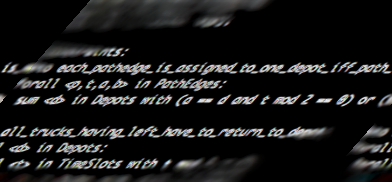CTN – Cooperative Truck Networks
Project Leader: Prof. Dr. Jörg Rambau
Contact: Prof. Dr. Jörg Rambau
Project start: 2016/02/22 Project end: 2018/07/02
Project team:
- Prof. Dr. Jörg Rambau
External partners:
- Dipl.-math. Bernd Nieberding, FH Erfurt
- Dipl.-WirtIng. (FH) Andy Apfelstädt M.A., FH Erfurt.

Project description:
APPLICATION BACKGROUND
If trucks of one company cover a long distance, then during the breaks of the drivers the truck is unproductive. However, companies may build a cooperative network in which trailers can be passed on from driver to driver. Then at least some of the transports may be carried out by putting together only near-home trips of the drivers from and to their depots. Given a number of long- and short-distance trips for full-truckloads and certain rules for the composition of long trips from near-home trips, we search for the best possible way to replace long-distance trips requiring overnight breaks by a sequence of non-empty near-home trips requiring no overnight breaks. The idea for such a business process stems from the I-LAN project at the FH Erfurt, with whom the Lehrstuhl Wirtschaftsmathematik (Prof. Dr. Jörg Rambau) cooperates. Our goal is the appropriate modeling of the task as a mixed-integer linear program.
CONTRIBUTION TO THE MISSION OF MODUS
A long-distance trip can be viewed as composed of short-distance trips (links) of half the maximal driving time of a driver. In order to replace a long-distance trip by a sequence of near-home trips, we have to match each link of the long-distance trip to the a trip from or to the depot of maybe another company's driver at the same time slot. This can be formalized by introducing binary variables for whether or not a link is carried out by a given company. All rules like "no empty moves for near home trips" and the like have to be expressed in these variables or variables dependent from them. Since the rules are not given but have to be developped for a most useful cooperation, a fast MILP model can help to check ideas for their savings potential in many "what-if" calculations.
RESULTS
The first simple model has shown that the basic MILP model can be solved very fast. However, the fraction of trips that can be carried out cooperatively is quite small. In further investigations it could be shown that flexibilizations of the rules can squeeze more trips in the cooperative network. The results have been published in the proceedings of the Operations Research conference in 2017 in a series of two contributions, one by the application team and one by the core team. This finishes our activity for the time being.

